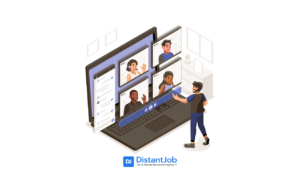A remote employee handbook is the most effective tool to keep track of your company’s mission and procedures. Especially in distributed teams, a comprehensive overview of who you are as a business is an essential strategy for coordinating different departments and, more importantly, navigating cultural differences and different work approaches.
You might ask what is the difference between an HR policy and employee handbook. While HR policies relate to contracts, workload, and employee’s wellbeing, an employee handbook includes everything a new hire needs to know about your company, products and team members.
Should You Create an Employee Handbook for Your Remote Team?
Yes! More than your company policy, an employee handbook is an in-house guide given to employees that explains the company’s rules, policies, and expectations. It includes details on job duties, workplace behavior, benefits, and procedures for things like taking time off and handling problems.
First, it helps distributed teams to be aligned on the company code of conduct and goals. For remote companies, it is a useful tool to provide all the necessary information and contact references. From ethical approvals to sales to product development, it allows your employees to find what they need and facilitate communications.
Secondly, a remote employee handbook is a way to present your company values and structure to new candidates and clients. While looking for information about your company, people can have an overview of your internal organization, diversity policy, and approach to remote work. More than a list of contacts, the handbook provides an overview of your identity as a company.
Last but not least, a remote employee handbook allows the space for your employees to share their feedback and ideas. For example, team members can improve their communication channels based on their projects, or help explain legal aspects related to remote work based on their own country. Beside being an effective tool to keep everyone on track, it is a way to expand and implement your company vision growing with your employees.
What Are the Key Elements of an Employee Handbook for Remote Teams?
Another question would be: what is included in an employee handbook? As an essential guide for your employees, the most correct answer is everything old and new employees should know about your company, wherever they are located.
Depending on the scale and type of company, the core content changes based on specific priorities and the company’s mission. However, there are some key elements you can’t miss in your employees’ handbook, especially if you run a remote company.
In short, here are the key employee handbook contents for remote teams:
- Company culture is about your mission, but also how your working practices and policies represent your vision
- Coordinate with your managers from each department and set up a shared policy on holidays, flexibility, sick days, etc. to have a common policy aligned with production demand.
- As a remote company, you must inform employees on their rights and obligations. Coordinate with your HR and legal department to have transparent contracts and benefit schemes regardless of the country of origin.
- Remember that an employee handbook is a precious tool, but it doesn’t replace a manager or good instructions. You will always have questions, and sometimes will need to update your policies. But it is important to start somewhere, and don’t be afraid of feedback!
Steps to Create an Employee Handbook for Remote Teams
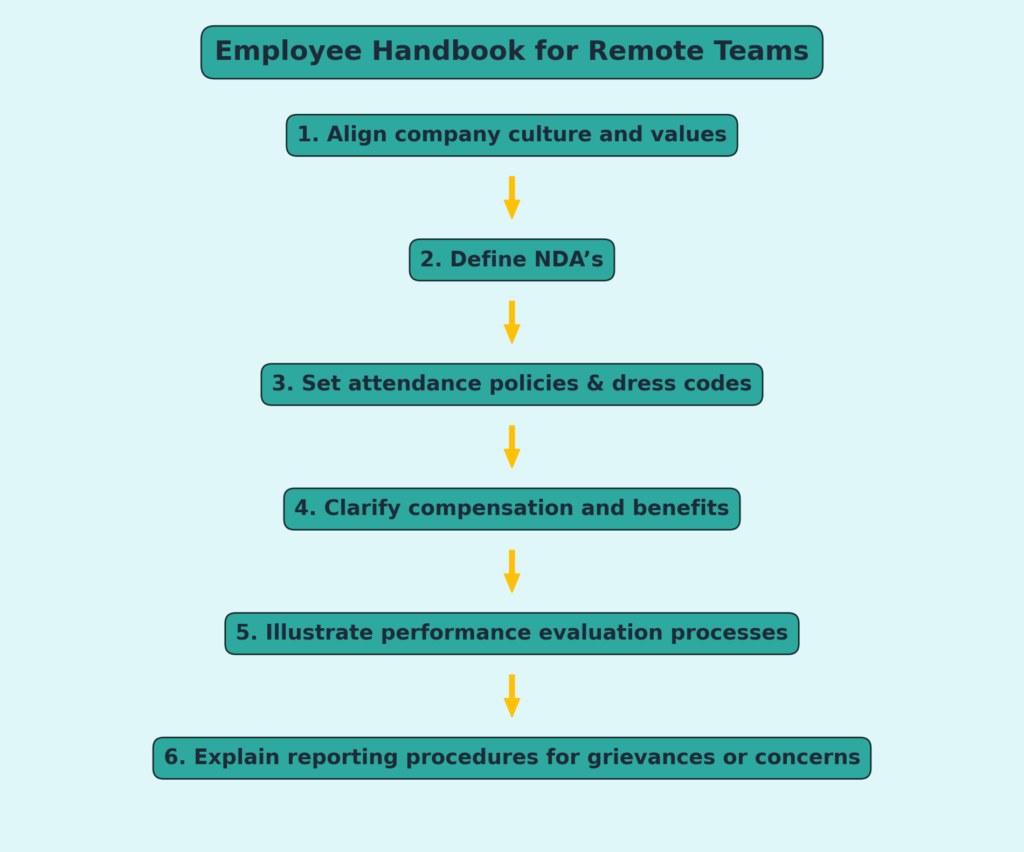
1. Align company culture and values
Clear values and company culture are essential for remote teams. Working from home has multiple perks, but it can be isolating. When employees don’t have clear directions, they can deliver less quality work, impacting overall performance.
Alongside flexibility, it is important to give clear instructions and standards, explaining how your mission aligns with your company goals and structure.
2. Define NDA’s
NDAs, non-disclosure agreements, are legally binding agreements to maintain information confidential with a non-authorized party.
Confidential information can include business and pricing plans, customer accounts, marketing campaigns, details for a new product, proprietary processes, trade deals, and so on. Including NDAs in your handbook has several benefits, for you and your new employee:
- A clear agreement delineates which information is protected, and the legal consequences for disclosure.
- When an organization needs to disclose a trade deal with third parties like vendors, NDAs protect the organization during the whole trading process.
- If an employee discloses confidential information, you have additional legal protection to the state-law misappropriation claim.
- Establish workplace conduct
Remote environments have less interaction, but employees still need to attend virtual meetings and are part of group chats.
As obvious as it sounds, it is important to set some ground rules to prevent people get offended by particular humor or comments. A global team also means that people have different sensibilities, and if employees don’t have a solid individual relationship, it’s important to create a safe nest to avoid misunderstandings.
3. Set attendance policies & dress codes
Working from home doesn’t mean working from your bed. Employees still have online meetings with clients, deadlines, and quality standards to meet. Even leaving as much flexibility as possible, it is important to be clear on your expectations.
For example, you require the camera on during calls and ask for a specific background when dealing with clients online. If you need mandatory attendance, share dates in advance and explain why it’s important to participate. This section is for you to illustrate the code of conduct you expect from your employees.
4. Clarify compensation and benefits
In this section, you can list your benefits and compensation.
For example, you provide compensation for co-working space renting to encourage healthy work-life balance, or health insurance covering the whole family. If you have a sales company, here you can explain your bonus system and previous cases. Here is the space to list what your company can offer and how new candidates can grow within your business.
5. Illustrate performance evaluation processes
Any company has an evaluation process and quarterly goals.
In this section, it is very important to explain what you expect and how each team or department will be assessed. While the individual employee’s performance is left to the team’s managers, the company productivity follows set processes that each team has to follow. Being clear from the start will help your manager to train new hires and help you keep up your quality delivery.
6. Explain reporting procedures for grievances or concerns
Finally, this section lists all the important contacts in the company and gives space to employees to share their feedback or concerns. It is important to offer a professional figure from HR or a neutral department as a referent, so that everyone feels safe to share complaints or concerns.
3 Employee Handbook Example For Remote Companies
Let’s examine some examples to see how to create the perfect remote handbook for your business.
GitLab Handbook
The GitLab Handbook is one of the most structured examples for big scale remote and distributed companies. Pioneer of remote workforce, the company is distributed all over the globe and it includes different departments. Alongside their company presentation, employees have instructions to use and edit the handbook. The guide provides an overview of the whole company structure, including different sections for each category.


Basecamp Handbook
Basecamp Handbook is a good example for up-scaling companies. As they mentioned in their introduction, their handbook appeared after 10 years, when the company grew in scale to 50 employees. Having a shared document helped new hires feel less lost, and gave a clear overview of the company’s practices. The list of sections is a mix of practical information and past cases, giving an overview of the company structures and reference contacts.

Glitch Handbook
Glitch Handbook is one of the best examples for startups and growing companies. Unlike the previous examples, here employees can customize their own copy and modify it with their team. Including all the useful information, the company handbook is an historical archive of documented policies and processes. It also provides a list of sections, allowing people to browse based on their priorities and adds up over time.
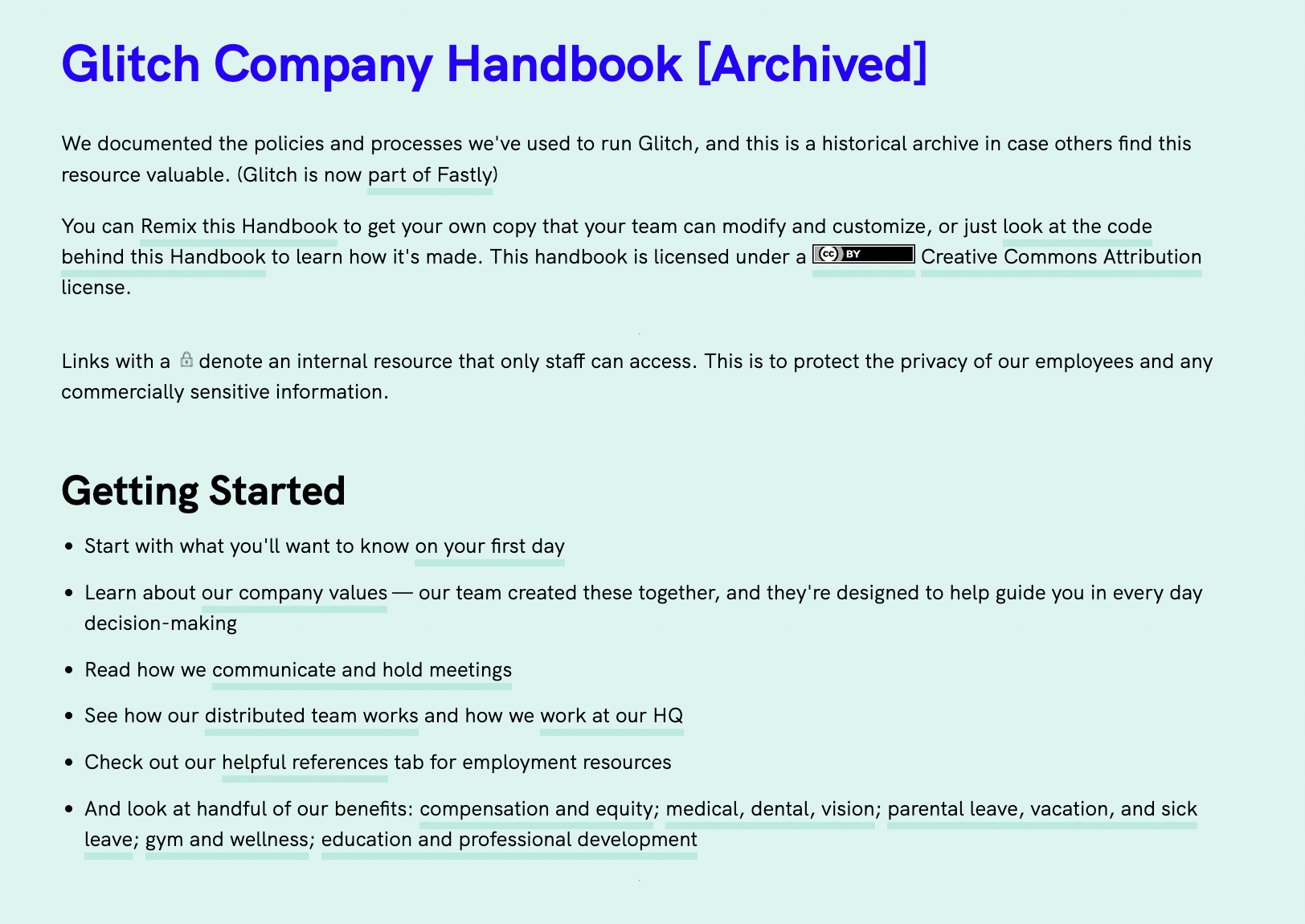
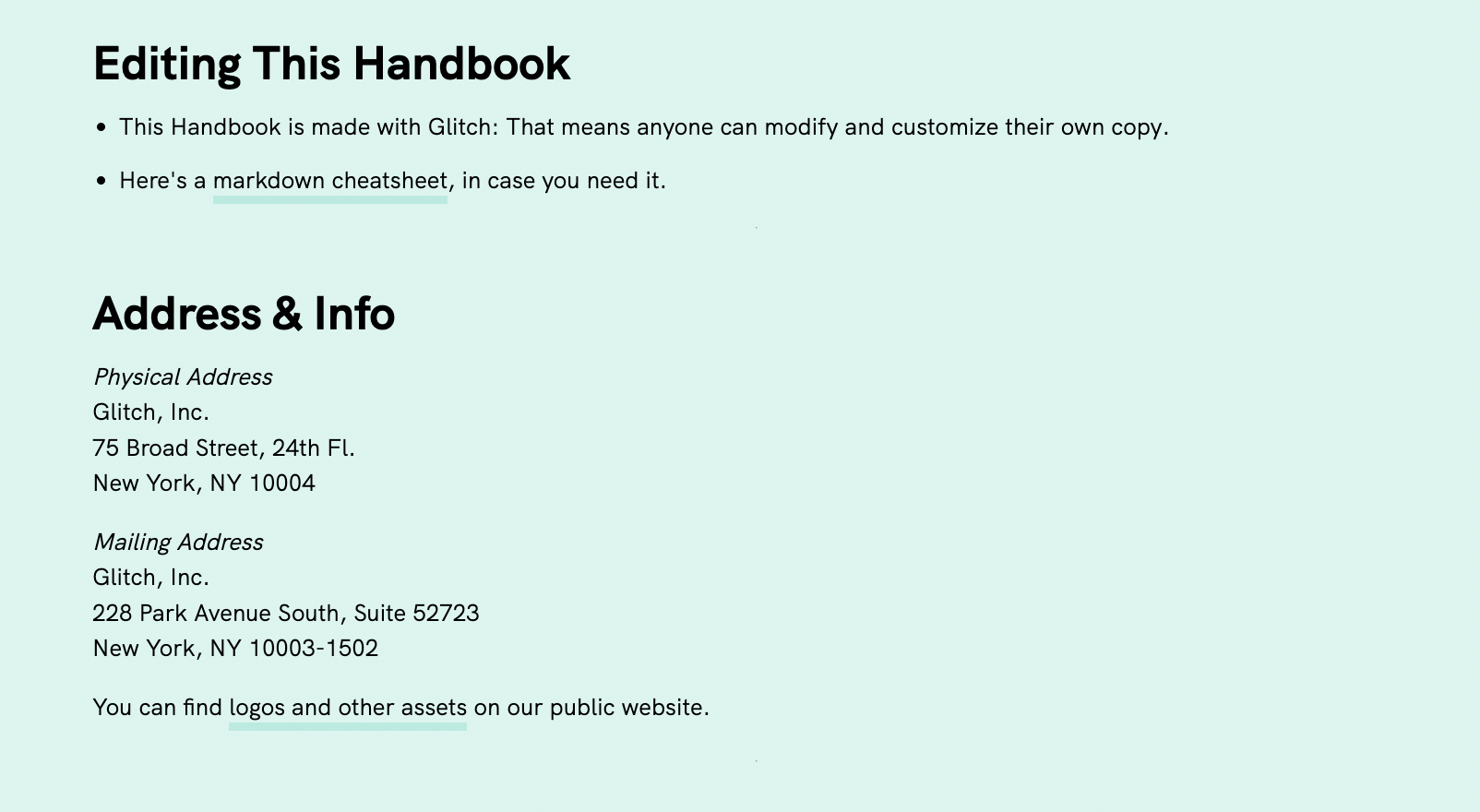
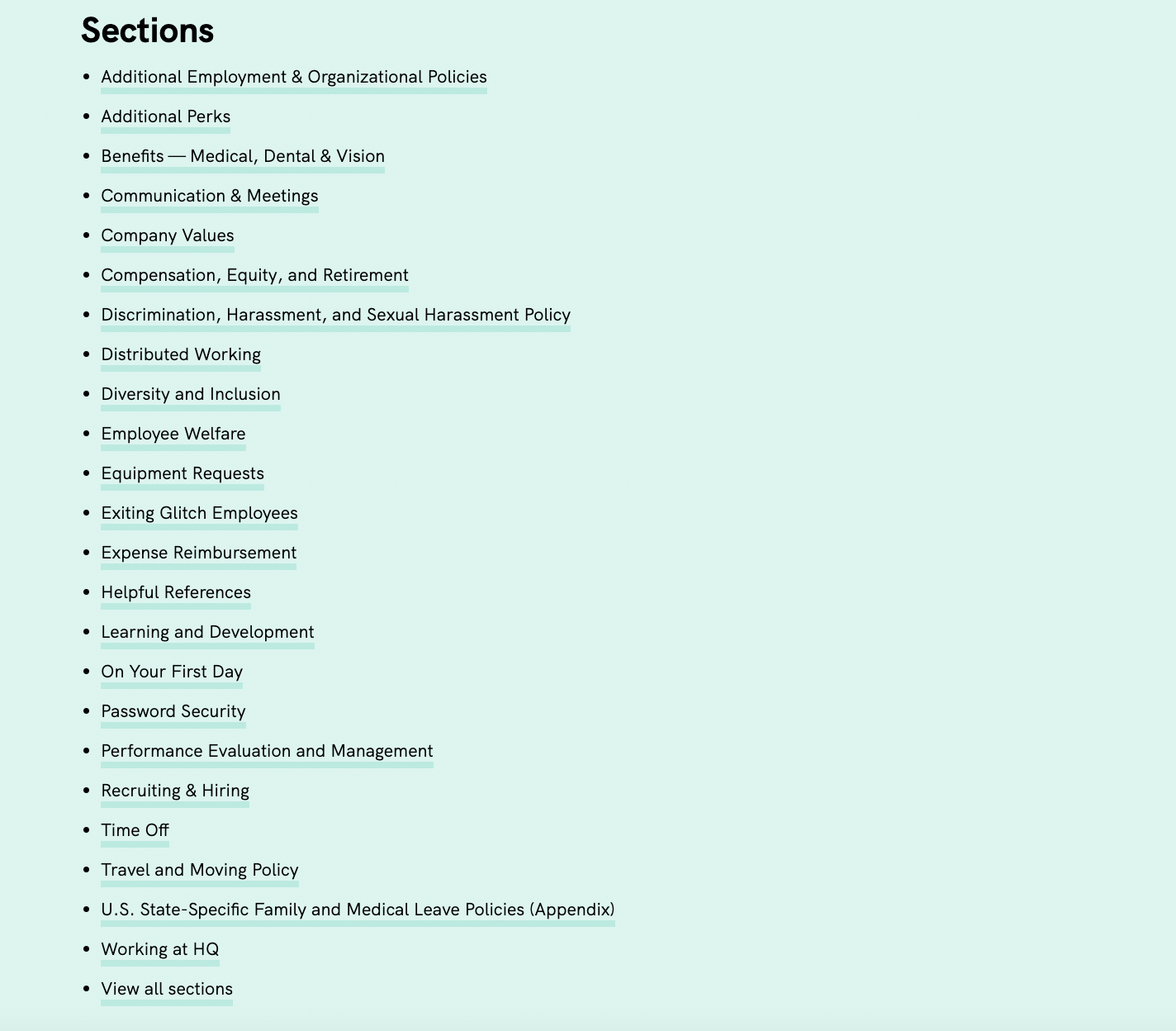
Conclusion
As we have seen in the previous examples, besides these core elements, employee handbooks are unique and based on the company’s story. The most important thing you must remember is to make a document that your employees will be willing to read. Add images, or choose an engaging writing style. This is a tool for you and your employees, not a manual!
If you want to hire the best employees worldwide, we can help you find talented and well-trained remote candidates to scale your company—don’t hesitate to contact us!




